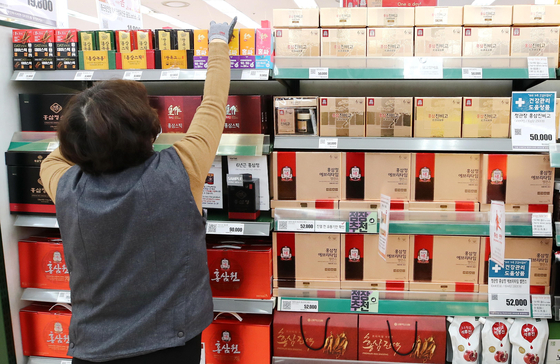
Last year, a survey found that 80% of households took health functional foods. The photo shows an employee displaying health functional foods such as red ginseng at a large supermarket in Seoul last year. yunhap news
It was found that 8 out of 10 domestic households are eating health functional foods. As interest in immunity increased due to the new coronavirus infection (Corona 19), an average of 3.7 health functional foods were purchased per household.
According to the results of the 2020 processed food consumer attitude survey released by the Ministry of Agriculture, Food and Rural Affairs on the 11th, the number of households who took health functional food last year was 79.9%, an increase of 10.1 percentage points from a year ago (69.8%). It was found that all age groups bought the most’vitamins and minerals’. In addition, people in their 20s and 40s bought fermented microorganisms such as lactic acid bacteria and probiotics, and those in their 50s and 60s bought ginsengs such as red ginseng.
The number of consumers looking for health functional food is expected to increase this year. 30.2% of those who answered that their purchases would increase over the next year were more than those who said they would reduce their purchases (0.3%). Consumers responded that they bought 1.2 health functional foods for gifts and 2.5 health functional foods for their own consumption in the past year.
Processed food is’simple’
There was also a change in the trend of purchasing processed foods such as ramen and instant rice. With the increase of’zipcock’ last year, consumers picked’noodles’ (16.3%) as the most purchased item. Processed meat products, which ranked first in the survey a year ago, fell to second place with 15.1%. The number of households who responded that they bought a lot of convenience foods such as home convenience meals (HMR) also showed a sharp increase from the previous year (7.8%) to 13.1%.
Processed foods were mainly purchased at large discount stores (36.4%), local small and medium-sized supermarkets (24.5%), corporate supermarkets (15.7%), and mail order sales (11.4%). In particular, the proportion of households purchased through mail-order (online) surged from 4% in 2019 to 11.4% last year.
The Ministry of Agriculture and Food and the Korea Rural Economic Research Institute (KREI) conducted a survey of 2002 households from July to September last year for this survey. Lee Si-hye, head of the Food Industry Policy Division of the Ministry of Agriculture and Food, said, “The trend of increasing interest in health and the coronavirus outbreak led to a significant increase in health functional food purchases and online food purchases.”
Sejong = Reporter Seongbin Lim [email protected]
